What Is a Digital Experience Platform?
By Ian Donnelly
02/21/2024

Crafting useful and seamless digital experiences for your customers is no longer an optional bonus for businesses. It’s now a financial imperative if you want to engage and retain a modern audience.
Today's customers interact and shop across multiple channels and through a variety of devices, and they expect experiences that are consistent and unified across every touchpoint. If companies don’t put their customers first, they’ll quickly lose their relevance and revenue.
That’s why digital experience platforms (DXPs) are so essential. These software solutions are designed to help enhance customer experiences and streamline digital experience management so brands can meaningfully connect with their shoppers at every stage of the customer lifecycle.
In this blog, you’ll learn why there’s a need for personalized experiences, see how a DXP helps in delivering those, and find out how you can get started with choosing a DXP.
What Is Digital Experience?
Digital experience refers to interactions between a customer and a business that’s made possible through digital technologies like websites, mobile apps, social media content, email campaigns, and more.
This type of experience is increasingly relevant in today’s digital commerce landscape. A customer’s relationship with your business can begin and end online, making the digital experience you provide a vital part of your overall strategy.
Understanding digital experience allows your business to be more proactive when it comes to creating personalized experiences that better engage prospective buyers, satisfy current users, and create long-lasting customer relationships.
What Is a Digital Experience Platform?
Gartner defines digital experience platforms as an integrated software framework for engaging a broad array of audiences across a wide range of digital touchpoints.
Organizations use DXPs to build, deploy, and continually improve websites, portals, mobile apps, and other digital experiences. They're designed to take care of the heavy lifting of data management and user experience, helping you cater to every aspect of the digital customer journey, from content development and deployment to analytics and fine-tuning.
This is increasingly important in an increasingly digitized world. Having a central platform to manage all your digital customer experiences across multiple touchpoints is a huge benefit for digital marketers, allowing them to focus on meeting customer needs and driving engagement.
With so many components in today’s digital experience, describing the role that a digital experience platform plays can get complex quickly. But there are two core principles that can help you understand the role of a DXP:
- It takes multiple integrated technologies to control a wide span of touchpoints
- There is a need for one central platform to be the control center for this expanded experience
Read this next: 2021 Gartner Magic Quadrant for Digital Experience Platforms
The Evolution of the Digital Experience Platform
The principles and technology behind DXPs have evolved with the demands of the digital consumer and digital worker.
Ultimately, it boils down to three stages: the introduction of the content management system (CMS), the need for web experience management (WEM), and the emergence of the DXP.
To understand how we got from the capabilities of the CMS to the innovation of the DXP, let’s break down the evolution of these different technologies and outline the key differences between them:
Content Management System (CMS)
When the CMS was first developed, websites were the be-all and end-all of digital experiences. The focus was on simply standing up an online store, and a CMS could easily build a basic e-commerce presence and start facilitating online transactions.
These basic platforms help businesses organize written content, images, data, and other collateral needed for their online presence, empowering businesses to publish without relying too much on IT.
The CMS helped businesses gain control of their digital presence, but also introduced new challenges by creating silos in organizations. As e-commerce got more complex with apps, social media, and other channels becoming parts of the experience, all these channels needed to be integrated into one unified whole.
Read this next: What Is a Content Management System and How Does It Work?
Web Experience Management (WEM)
As digital commerce expanded with new customer channels popping up, cross-departmental collaboration began to rely on sharing digital information. And with this need for streamlined data, WEM emerged.
WEM systems introduced rule-based personalization to the online experience with the ability to collect user behavior, define personas, and create and deliver unique content to a targeted audience.
Most importantly, WEMs allow companies to share content, data, logic, and other elements across channels consistently.
Digital Experience Platform (DXP)
But digital experiences quickly moved beyond just content. Now e-commerce businesses want to share any type of asset, or group of assets, across any digital touchpoint — online, in-store, on billboards, through customer portals, across e-commerce systems, and more.
It's become clear that the digital experience is no longer just a way to get people in the door, but critical to growing customer satisfaction and loyalty post-acquisition. The digital journey has expanded, and more back-end applications are being used by different departments to handle their slice of that journey.
For the customer experience to remain consistent from acquisition to advocacy, these back-end systems need to integrate. Digital is no longer just in the marketing team's hands — the entire business is responsible for it.
This need for a connected, consistent experience — both internal and customer-facing — led to the rise of the more agile and encompassing DXP.
At its core, a DXP aims to supercharge the way the digital experience is delivered. And all of the systems we’ve outlined — CMS, WEM, and DXP — are after the same thing: making the interaction between customer and brand meet both parties' needs.
DXP vs. CMS
A CMS is the foundational system for managing content. It’s still an essential part of a DXP, but the rise of different channels and interconnected devices demands more from the digital experience — simply delivering content over web pages and applications is no longer enough.
To make experiences more robust and connected, web experience management systems were developed to expand on CMS platforms and change websites from brochures into an integral part of the customer journey.
WEM gave companies new ways to collect customer data, define personas, and create unique content for specific audiences. Plus, it connected new digital channels such as mobile apps and social media.
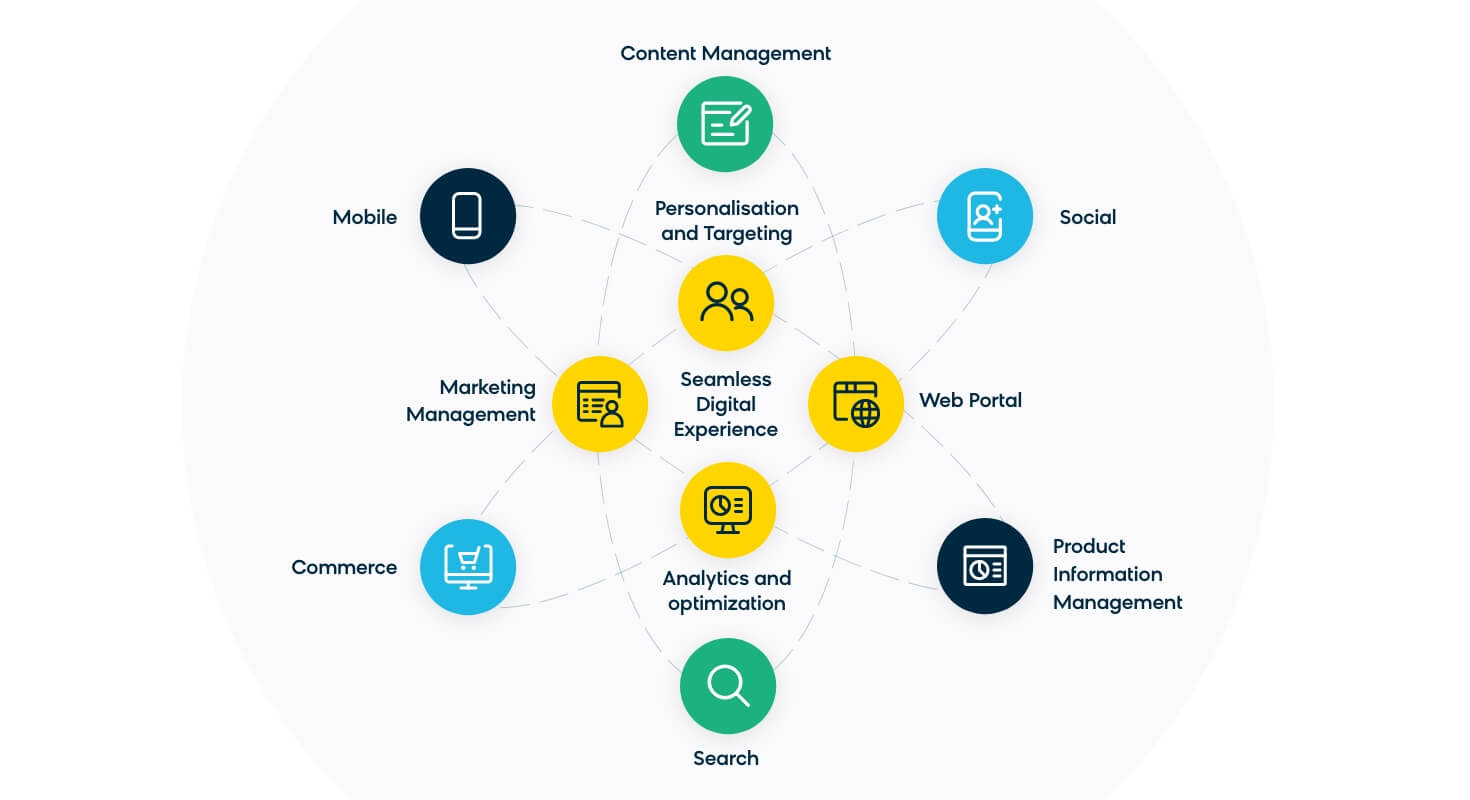
However, marketers found that these systems still couldn’t seamlessly connect all the aspects of their business and offer the personalized experiences that customers crave. Data activation, profile building, and applying business logic are limited when all your channels are siloed and not communicating in real time.
This realization led to the development of the DXP, an open platform that easily integrates with other systems and departments and enables companies to craft truly personal experiences for customers, which is something that modern companies need more than ever.
The Essential Components of a Modern DXP
A modern DXP is open, intelligent, and comes with a number of tools and capabilities to optimize and personalize digital experiences. Let’s take a closer look at these components and features:
A Strong Foundation in Data
Scaling personalized digital experiences requires a platform with a deep understanding of customers and products. At its core, a DXP must have a strong foundation in data.
The data comes in the following forms:
- Product data: The products you offer and their attributes (for example, a lamp can be of various sizes, types, or makes).
- Content data: Typically the articles, videos, and images that describe your offering.
- Marketing data: The campaigns, creatives, email lists, mobile numbers, and other data you may use in your digital marketing programs.
- Interaction data: The various clicks, swipes, email opens, views, locations, and other ambient data about your customer.
- Transactional data: The past purchases or transactions customers may have made.
Openness
A great DXP should offer the ability to connect to third-party systems so communication can flow between them. Incredible digital experiences are often made of many different components, which is why DXPs are open and democratized for a new era of composable commerce.
Microservices architecture enables this. With this architecture, the backend logic of your digital experience is decoupled from the front-end presentation, so developers and marketers can make changes quickly and independently of each other. This also means that improvements can be made modularly, and changes can be deployed in one area without disrupting the rest.
This architecture has opened the door for headless commerce, which is the separation of the front end and back end of an e-commerce application. Headless commerce offers businesses the freedom and flexibility to build their ideal digital experience.
Built-in Algorithms Backed by Artificial Intelligence
The ability to ingest and understand various types of data is what distinguishes a modern digital experience platform from the tools and systems that came before.
Your experience spans across a growing number of touchpoints, you have data flowing in from multiple sources, and your business is continuing to grow in customer base and in products and services offered — how do you continue to maintain and improve it? Even more importantly, how do you find time to innovate?
Artificial Intelligence is the key here. It can assist you all across the experience, from doing the grunt work that powers personalization to discovering hidden insights within your data.
Having AI sitting at the heart of your experience not only means it can use the connected data to give your customers what they want, but it can also use that data to show you insights you didn’t even know were there to look for. A modern DXP should have customized algorithms that learn and improve the experience over time.
There are four core types of algorithms:
- Personalization: These algorithms understand customers and ensure that the offerings you put in front of them represent your best understanding of their current intent. Personalization algorithms ensure that each customer gets a unique experience.
- Relevance: Such algorithms take what the customer explicitly expresses, perhaps by entering something in a search box or by scrolling through your app, and ensure that the right offering is presented to them.
- Business optimization: What if you offer different types of sweaters and they are all a good match for the customer? Business optimization algorithms will rightly display the sweater that maximizes revenue, profits, or any other business goal for your digital business.
- Marketing optimization: Digital experiences are certainly about the experience, but they are also marketing vehicles for campaigns. Marketing optimization algorithms ensure that your business shows up in search engines, social media feeds, email messages, and more.
The DXP, sitting at the connected heart of the experience, should be the place where this intelligence is housed. It needs to communicate with your entire solutions toolkit to keep learning about your visitors and continuously, automatically, improve their experience. It’s only then that true personalization can be achieved.
Experience Management Tools and Advanced Capabilities
To help businesses personalize and optimize experiences, a DXP should come with the following tools and capabilities:
- Channel management: The ability to manage multiple channels — various websites, mobile applications, voice interfaces, or other customer-facing channels.
- Digital merchandising: The ability to take products and services and display them in the way that most effectively drives outcomes.
- Content management: The ability to edit, preview, and manage the content elements of an experience.
- Recommendations: The ability to build unique personalized recommendations so that various cohorts of customers can benefit from the wisdom of similar users or buyers.
- Search management: The ability to manage the search capabilities to ensure that the most relevant content or products match what the user is looking for.
- Insights: The ability to deeply understand customers, products, and content elements to continuously recommend how experiences might improve.
- Testing and targeting: The ability to select specific groups of customers, offer uniquely targeted content or products to them, and then test against the target key performance indicators and iterate better results.
API-First Architecture
In the fast-growing martech space, businesses should have the freedom and flexibility to innovate by adding or replacing solutions with minimal disruption to the experience as a whole.
While DXPs come with pre-built capabilities, the best ones can easily integrate with a variety of data sources and systems. This is where API-first design comes into play.
While AI is one baseline technology that forms the core of a DXP, another key component of a DXP are application program interfaces (APIs) in the cloud, which ensure the right experience can be delivered to a user at the right time, no matter how they choose to interact with a business.
A great DXP offers a robust collection of APIs that developers can connect to their front-end application. The APIs enable a DXP to be consumed modularly, giving businesses flexibility and the ability to iterate as market demands and consumer behaviors and expectations evolve.
The Advantages of a DXP
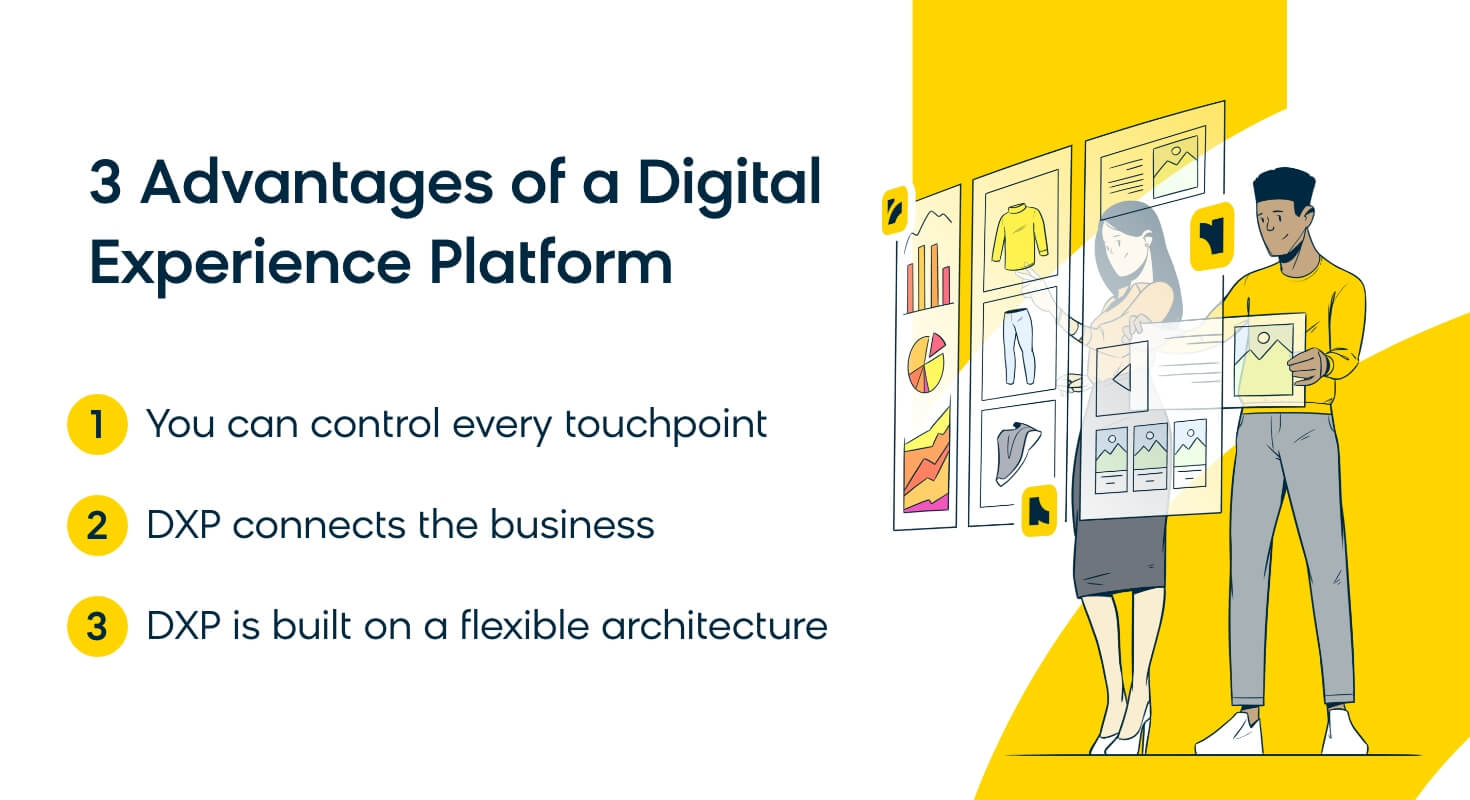
Control Every Touchpoint
No matter what kind of business you run, the number of customer interaction points you need to manage is rapidly growing. Not only do you have to offer each new touchpoint as quickly as your customers expect them, but you also have to keep all your connections consistent in content, feel, and logic.
This is where API-first design shines. APIs hand out the raw information in a predefined way, and every touchpoint can present that raw information in its own structured way.
This means you can write an FAQ document once and it can be used across web, mobile, customer portals, kiosks, chatbots, voice assistants, and any other digital touchpoints you choose. Update that FAQ document once, and it’s updated everywhere.
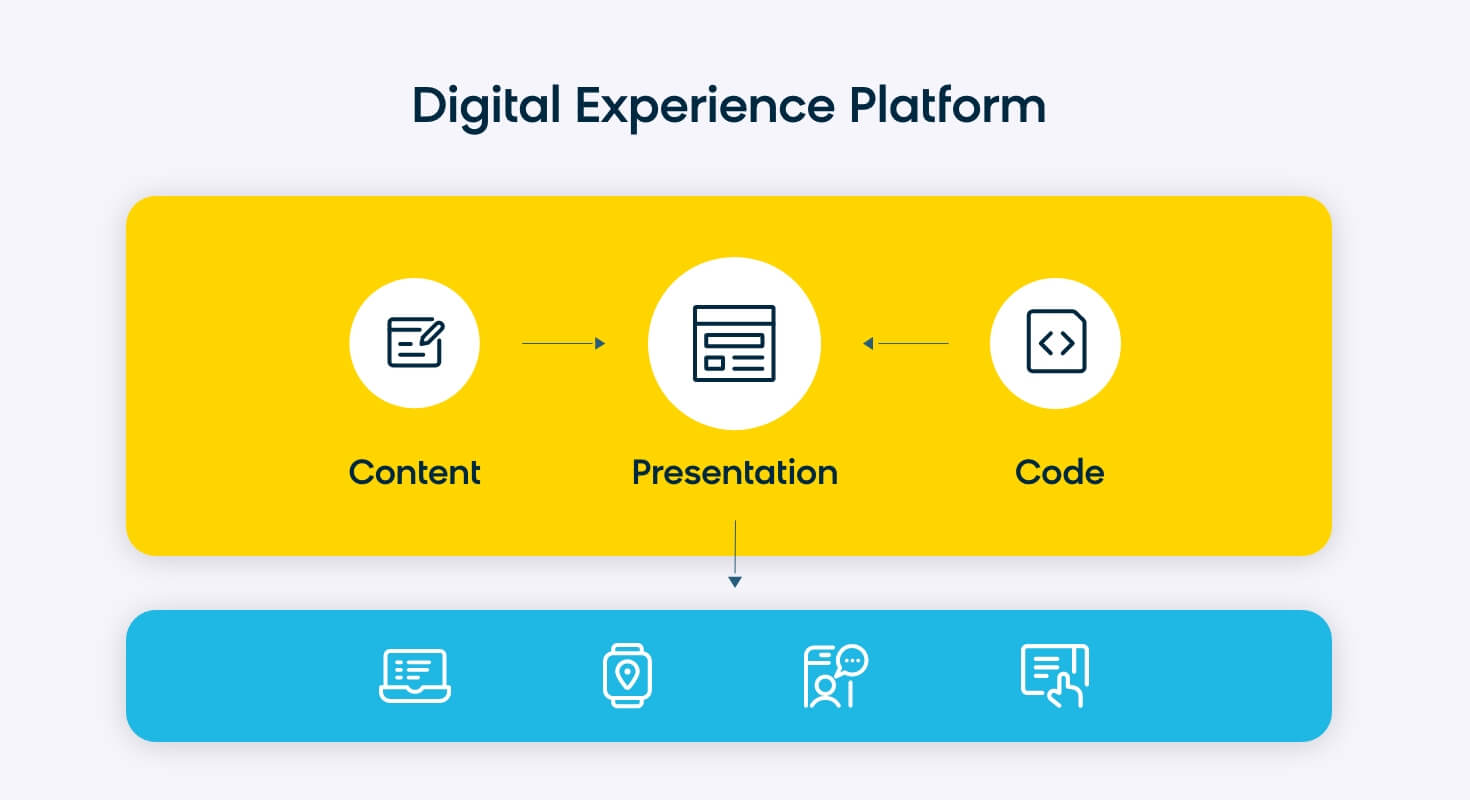
API sharing isn’t limited to simple content and data, either. It can provide entire elements as a service. For instance, you can define pricing logic once and share it with apps, third-party retailers, “buy me” buttons on social media, and wherever else you’d like consistent information to be available.
Connect Your Business
A DXP is not the only tool you need in your martech kit, but it is one of the most integral pieces of tech you can incorporate into your e-commerce strategy.
You need a marketing platform to bring customers in the door, a commerce platform to handle inventory and transactions, a support environment to work with existing customers, and the freedom to choose other point solutions that fit your unique needs. A DXP sits at the center of these, using APIs to aggregate and orchestrate data to determine and show customers the right experience at every turn.
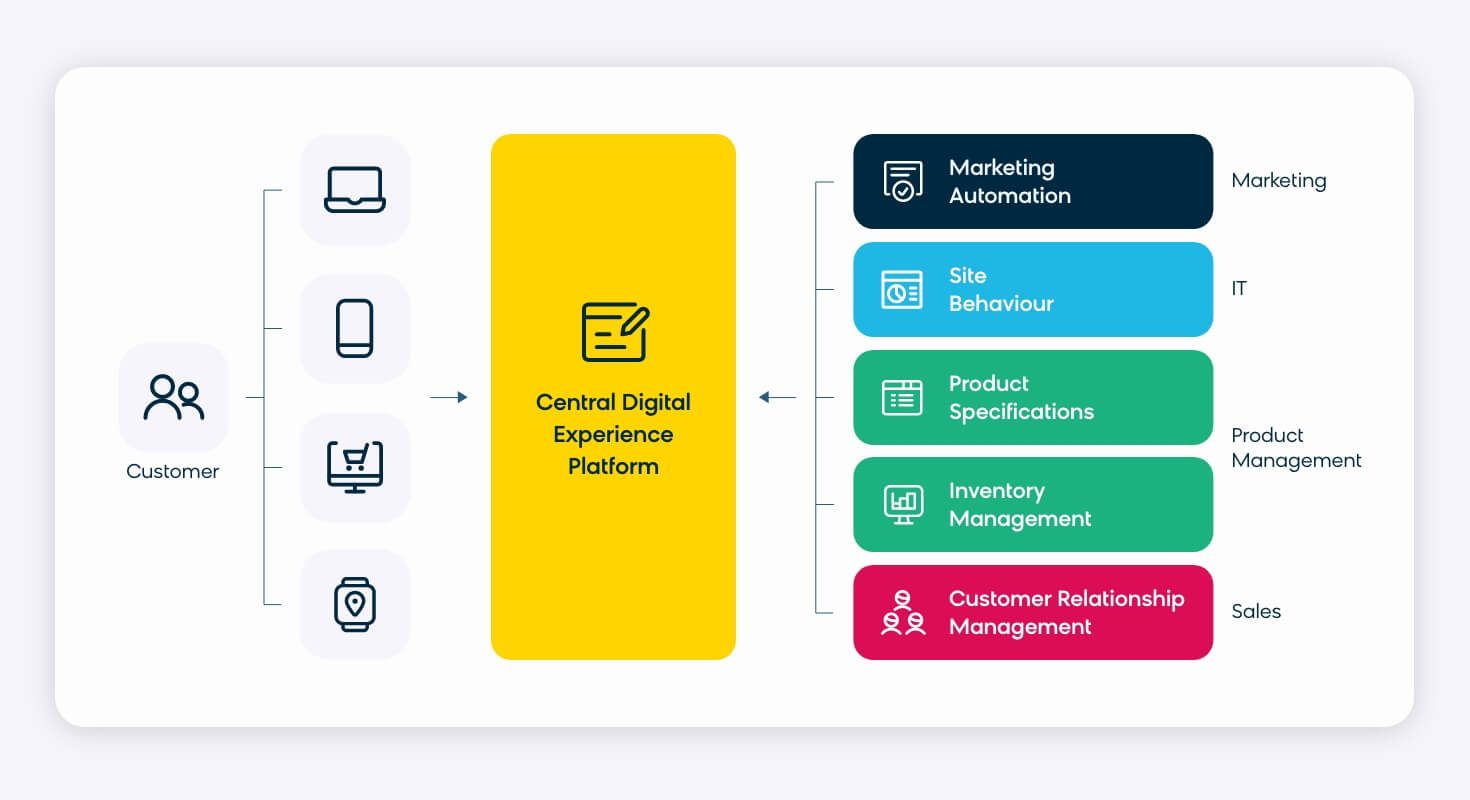
An open DXP can bring every best-of-breed tool that impacts the experience together with minimal interruption. And if a department has a preferred tool in place, they can simply connect it to the DXP with APIs. You can also add and remove tools with ease, which makes experimentation much less daunting.
Leverage a Flexible Architecture
For all these connections to work, the underlying structure of a DXP has to be flexible. Back-end logic needs to be decoupled from front-end presentation, so developers and marketers can make changes quickly and independently of each other.
This also means that improvements to the platform can be made modularly, making and deploying changes in one area without disrupting the rest. This is especially important when building and deploying custom components or integrations with other best-of-breed systems.
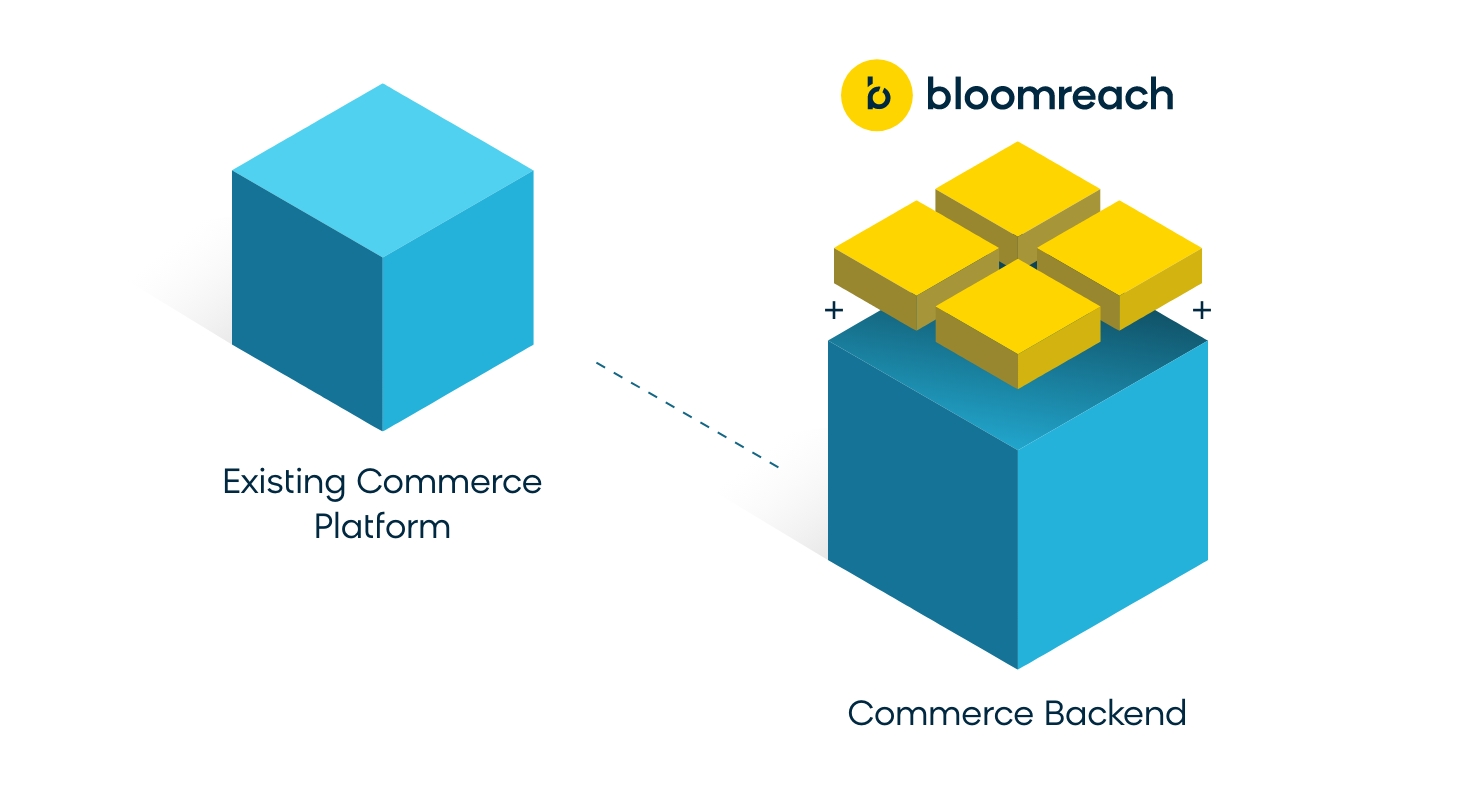
This flexibility also allows businesses to get the most out of their DXP.
They can use content as a service (CaaS) to store and dish out content in a structured API, or as experience as a service to edit in a WYSIWYG style and serve whole elements out to front-end applications. This provides full site delivery, where marketers can edit and publish the content and presentation directly from the platform.
Read this next: The Ultimate Guide to Headless Commerce
5 Key Ways That DXPs Help Businesses Address Today's Customers
Get Actionable Insights
A DXP connects your internal operational systems with all your digital channels — not just web, mobile, and social media, but also in-store, on billboards, in customer portals, and via e-commerce systems.
This enables customer data capturing, processing, and profiling, which gives you a unified 360-degree view of the customer.
So when your customer service team handles a disgruntled tweet, they‘ll know the customer’s history beforehand. Or, your sales department can see the individual interests and lead score of a potential customer before calling.
Become Customer-Oriented
By connecting your DXP with internal systems, you can track customers, map their customer journey, and identify crucial bottlenecks. This enables you to reengineer your business practices and streamline your efforts.
This is exactly how the disruptors and industry leaders of today’s modern market operate: by offering a superior customer experience.
Connect Best-of-Breed Solutions
Companies typically use best-of-breed technology that has been chosen for specific use cases. As an open platform, a DXP can connect to these best-of-breed solutions without integration troubles or data issues.
This means you can switch or upgrade a specific marketing tool as needed, making your marketing agile and allowing you to grow your personalization in manageable steps.
Optimize Content Usage
Creating personalized content should be a comprehensive goal. A DXP allows you to coordinate your content to drive reuse across multiple environments by decoupling the presentation layer from the content and its metadata.
With a DXP, your content becomes like water, filling each container completely and fittingly. This means your content investments will yield better results.
This can be a helpful benefit for B2C as well as B2B businesses. Across all industries, B2B companies are facing the demand to make B2B shopping just as easy as B2C. And like B2C, B2B shopping behavior will continue to be driven by digital developments.
A DXP helps both B2B and B2C companies create a seamless customer experience that builds stronger customer connections and brand loyalty.
How a DXP Works With AI
Having AI intrinsically involved in a DXP, where it has access to data from every tool and touchpoint, is essential for modern businesses. But what does this actually look like in practice?
Here’s how AI can improve your digital experience, from acquisition to loyalty:
Semantic Search
We asked 500 people to describe a red dress — they came up with 129 words for “red,” 275 descriptions of the belt, 105 descriptions of the dress length, and 216 words to name the occasion at which one would wear the dress.
That’s over 80 million combinations of search terms for one item. Humans simply can’t keep up with mapping all these terms to the right results. That’s why site search needs the help of artificial intelligence to deliver the most relevant results, at scale, for any search query.
AI-powered semantic search helps solve this problem. Artificial intelligence can make search results more comprehensive, seamless, and meaningful by understanding exactly what the prospect is trying to ask and what the user intent is behind the arrangement of keywords, keeping your visitors happy with their experience and continuing their customer journey.
Read this next: Semantic Search Explained in 5 Minutes
Contextual Personalization
For many companies, personalization is rule-based and left on the fringes of the customer experience. But manual rules can only go so far.
A person visiting their insurance website on a weeknight via a desktop at home will have completely different needs than when they visit the same site at 2 a.m. on a mobile phone while abroad.
Writing specific rules for each of these micro-journeys a visitor might have would take an eternity — and you’d probably still miss some vital steps.
To achieve a tailored experience, you need contextual personalization that takes into account every piece of content presented, the device used, customer behavior, and successful conversion paths. AI can harness this contextual data, analyze these insights, and select a content variant that best suits the customer’s needs.
With contextual personalization, AI will deliver content variations across various channels (like on-site banners, SMS messages, and email campaigns) to customers that are historically inclined to engage with them. Plus, AI can learn, deliver, and learn again which patterns lead to better outcomes, for which people, and at which times.
This type of personalization needs to happen at the core of the experience, not on the fringes. And a DXP platform can make it happen.
AI-Powered Analytics
Having AI sit at the heart of your experience not only means it can use your data to give your customers what they are looking for, but it can also use that data to show you insights you didn’t even know were there.
When it’s woven into your digital experience management process, AI can open new doors to business insights by parsing through your data, identifying which patterns and trends are actually making an impact, and giving you insights on what you can do to boost or change those patterns.
The range and scale of real-time insights and predictive analytics that AI offers have the power to completely transform your business. Not only does AI make every component of your marketing tech stack more efficient and unified, but it also frees up valuable time for the people behind your brand to focus their efforts on making your digital experience truly unique.
Do You Need a DXP?
While some businesses can manage with just the core principles of a CMS — version management, workflow, authorization, and content organization — these are just the fundamentals of the digital experience.
For modern brands with multiple touchpoints, a diverse audience, and a business stake in digital, a DXP is an incredibly valuable tool to adopt and implement.
Businesses urgently in need of a DXP are those with multiple back-end systems and front-end tools currently in silos across the digital customer experience, and that have marketers and developers hungry to innovate with highly differentiated customer experiences.
Deciding if you need a DXP or are satisfied with a CMS requires a critical look at where your digital experience is today. And even more importantly, you need to decide at what level you want it to perform in the next five years.
Ultimately, the right platform is the one that efficiently supports your needs at the right level.
Read this next: How Digital Transformation Is Driving Customer Experience
Transform Your Digital Experience With Bloomreach
To fully utilize a DXP, nothing short of a digital transformation is needed. It’s not just about creating a digital experience — it’s about creating the best digital experience. Having an effective website or an app is just the starting point.
That’s why Bloomreach offers a unique combination of solutions that can connect and refine your e-commerce business, building the next-gen digital experience you’re searching for.
The Bloomreach Commerce Experience Cloud is so much more than a digital experience platform — it’s an all-in-one marketing solution purpose-built for commerce. It is the only platform that combines deep customer data with deep product data, along with commerce-specific AI designed to optimize revenue growth.
With the omnichannel marketing capabilities of Bloomreach Engagement, the e-commerce search and merchandising tools of Bloomreach Discovery, and the headless content management of Bloomreach Content, you can create comprehensive e-commerce experiences built for every customer.
The key to Bloomreach’s unprecedented offerings is Loomi, our AI built for e-commerce that serves as the connective tissue across our suite of products. With Loomi, you can power a seamless e-commerce experience across every channel, in real time, and at scale.
Interested in learning more? Visit our website to read all about our AI, browse Loomi use cases, and see what our suite of products can do for you.
Found this useful? Subscribe to our newsletter or share it.






